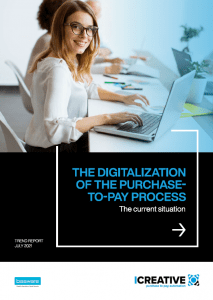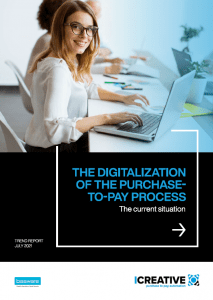2 min read
Research findings: Significant differences in the degree of P2P automation
Editorial ICreative
Sep 23, 2021 5:31:01 PM

Although Dutch companies are receiving ever fewer paper-based invoices, electronic invoices have not yet become popular. On average, 74% of invoices are submitted as a PDF attachment in an email. Meanwhile, just 15% of Dutch businesses can process invoices completely automatically. These are the key findings from research conducted on ICreative’s behalf into the digitalization of the purchase-to-pay process.
>> DOWNLOAD THE FULL TREND REPORT FOR FREE
A few months ago, ICreative commissioned a study into the challenges and trends in the digital transformation of invoice processing. A total of 39 Dutch organizations were surveyed, including 23 with more than 500 FTEs. The results revealed significant differences between the organizations in every respect.
 All of the respondents have at least some responsibility for the purchase-to-pay process. The most common roles among those surveyed were financial manager, CFO, financial director, business controller and finance controller. The total finance department comprises 6 or more FTEs at 85% of the organizations, and more than 100 FTEs at 11% of them.
All of the respondents have at least some responsibility for the purchase-to-pay process. The most common roles among those surveyed were financial manager, CFO, financial director, business controller and finance controller. The total finance department comprises 6 or more FTEs at 85% of the organizations, and more than 100 FTEs at 11% of them.
Digitalization of invoice processing
One company said it still receives around 40% of its invoices by post, but across the board the paper-based invoice has almost died out with close to 70% of the respondents indicating that less than 10% of all the invoices they receive are on paper. However, electronic invoices (XML, UBL, etc.) have not yet become popular, with almost 30% of the respondents saying that e-invoices account for less than 5% of the total.
The Accounts Payable process is far from fully automated within most of the organizations, with fewer than 15% of the respondents able to process invoices automatically. In other words manual intervention is still required regularly, and actually in most cases for 70% of the respondents.
The study also revealed that working with purchase orders has still not become the norm. Many companies do regularly have a purchase order in the system but, once again, there are huge variations between organizations; some organizations almost always create a purchase order, while others only do so in half of the cases.
Invoices not always paid on time
Many organizations said that they are able to pay invoices more or less on time, and one respondent even claimed that all invoices are always paid on time. However, a surprisingly high 62% admitted that they do not always pay on time. When asked why, almost 70% responded that the approval process takes too long. Other reasons given by the respondents included the high level of manual intervention required, the fact that invoices get lost or are forwarded to the wrong person, or that a cash policy causes late payments.
One thing is for sure: late payments cannot be blamed on lack of insight, since almost 90% of the respondents indicated that they have a clear overview of outstanding invoices, and 78% of them said that the data in their systems is accurate.
Other projects often take priority
Although 36% of the respondents stated that their existing software solution offers sufficient capabilities, almost 80% of them are nevertheless planning to invest in the purchase-to-pay process over the next two years. This is primarily aimed at improving efficiency (doing the same amount of work with fewer people). In fact, that reason was mentioned by all respondents. Besides efficiency, the second most important goal of automation is to gain control of indirect spend. While the study revealed a clear intention and need to invest, the main obstacle is the fact that other projects often take priority.







